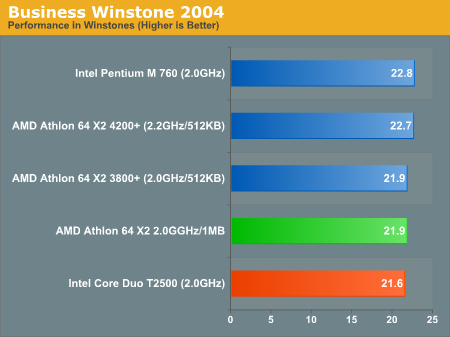Intel Core Duo (Yonah) Performance Preview - Part II
by Anand Lal Shimpi on December 19, 2005 12:55 PM EST- Posted in
- CPUs
Overall System Performance with Winstone 2004
Business Winstone 2004
Business Winstone 2004 tests the following applications in various usage scenarios:
The FP/SSE enhancements to Core Duo have no chance to shine in your everyday run-of-the-mill business applications like Word and Outlook, not to mention that the workload is not heavily multithreaded, so there's no benefit from a dual core processor. So from a performance standpoint, all we see from the Core Duo is a similarly clocked processor to the Pentium M 760, but with a higher latency L2 cache, which explains the performance deficit.
The Athlon 64 X2 running at 2.0GHz with a 1MB L2 per core manages to slightly outperform the Core duo T2500, however the performance margin is negligible.
Multimedia Content Creation Winstone 2004
Multimedia Content Creation Winstone 2004 tests the following applications in various usage scenarios:
Not all of the Core Duo's advantage over the Pentium M is due to its dual core nature, but it does account for some of it.
But as we saw in our original article, at 2.0GHz, the Core Duo T2500 just isn't able to offer performance comparable to the Athlon 64 X2 at the same speed. It is worth noting that L2 cache size doesn't really make a difference here to the X2 at all, just clock speed. Thanks to the Athlon 64's on-die memory controller, the architecture is inherently less sensitive to cache size than more conventional designs that rely on an external memory controller.
Business Winstone 2004
Business Winstone 2004 tests the following applications in various usage scenarios:
. Microsoft Access 2002
. Microsoft Excel 2002
. Microsoft FrontPage 2002
. Microsoft Outlook 2002
. Microsoft PowerPoint 2002
. Microsoft Project 2002
. Microsoft Word 2002
. Norton AntiVirus Professional Edition 2003
. WinZip 8.1

The FP/SSE enhancements to Core Duo have no chance to shine in your everyday run-of-the-mill business applications like Word and Outlook, not to mention that the workload is not heavily multithreaded, so there's no benefit from a dual core processor. So from a performance standpoint, all we see from the Core Duo is a similarly clocked processor to the Pentium M 760, but with a higher latency L2 cache, which explains the performance deficit.
The Athlon 64 X2 running at 2.0GHz with a 1MB L2 per core manages to slightly outperform the Core duo T2500, however the performance margin is negligible.
Multimedia Content Creation Winstone 2004
Multimedia Content Creation Winstone 2004 tests the following applications in various usage scenarios:
. Adobe® Photoshop® 7.0.1All chips were tested with Lightwave set to spawn 4 threads.
. Adobe® Premiere® 6.50
. Macromedia® Director MX 9.0
. Macromedia® Dreamweaver MX 6.1
. Microsoft® Windows MediaTM Encoder 9 Version 9.00.00.2980
. NewTek's LightWave® 3D 7.5b
. SteinbergTM WaveLabTM 4.0f

Not all of the Core Duo's advantage over the Pentium M is due to its dual core nature, but it does account for some of it.
But as we saw in our original article, at 2.0GHz, the Core Duo T2500 just isn't able to offer performance comparable to the Athlon 64 X2 at the same speed. It is worth noting that L2 cache size doesn't really make a difference here to the X2 at all, just clock speed. Thanks to the Athlon 64's on-die memory controller, the architecture is inherently less sensitive to cache size than more conventional designs that rely on an external memory controller.










103 Comments
View All Comments
ncage - Monday, December 19, 2005 - link
I swear this is the best first post ive ever seen. Good Post Alex. Ya competition is very good for the market. I think intel is starting to get back on track where they need to be. It all comes down to clock speed and cost at launch. What improvements will we see with the launch of amd's next chip other than ddr2 which right now i don't really care about and possibly more cores (at least for the opteron). I am not dogging amd because for about 3-4 years ive only used AMD chips but i think amd has to raise the bar even more.Calin - Tuesday, December 20, 2005 - link
DDR2 for AMD would be great at least for a few things:moving to single channel DDR2 memory would decrease costs (in mainboards and a bit in processors)
moving integrated graphics to single or dual channel DDR2 would increase graphic performance and overall system performance in relation to single or dual channel DDR
As for the high end, I really don't think an increase in memory bandwidth will help - not even for dual core processors. Maybe for a quad core, but quad cores are certainly for servers, and I don't know about registered DDR2 memory to be used in them.
Hmmm, you could try an Opteron Dual Core with single channel DDR memory, to see how much performance would be lost by going quad core, dual DDR.
mlittl3 - Monday, December 19, 2005 - link
I agree with both Alex and ncage. I really disliked Intel all through out the Pentium4/Net-burst days. They were just releasing marchitecture with no improvements whatsoever. I loved AMD for their innovation and performance/watt.Now both companies are equal but I don't think we will see the huge fall AMD suffered from when Intel released the Pentium 4 to compete with the Athlon/K7 architecture. The beauty of competition is showing its bright colors right now. If we only had Intel, we would have a very hot/power consuming inefficient Pentium 4 based on net-burst to play Quake 4 at 5fps right now.
Its time for the fanboys to turnover a new leaf. Go Intel and AMD!!! We love both you guys.